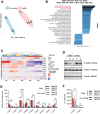Biomimetic Approach of Brain Vasculature Rapidly Characterizes Inter- and Intra-Patient Migratory Diversity of Glioblastoma
- PMID: 38747088
- PMCID: PMC11671864
- DOI: 10.1002/smtd.202400210
Biomimetic Approach of Brain Vasculature Rapidly Characterizes Inter- and Intra-Patient Migratory Diversity of Glioblastoma
Abstract
Glioblastomas exhibit remarkable heterogeneity at various levels, including motility modes and mechanoproperties that contribute to tumor resistance and recurrence. In a recent study using gridded micropatterns mimicking the brain vasculature, glioblastoma cell motility modes, mechanical properties, formin content, and substrate chemistry are linked. Now is presented, SP2G (SPheroid SPreading on Grids), an analytic platform designed to identify the migratory modes of patient-derived glioblastoma cells and rapidly pinpoint the most invasive sub-populations. Tumorspheres are imaged as they spread on gridded micropatterns and analyzed by this semi-automated, open-source, Fiji macro suite that characterizes migration modes accurately. SP2G can reveal intra-patient motility heterogeneity with molecular correlations to specific integrins and EMT markers. This system presents a versatile and potentially pan-cancer workflow to detect diverse invasive tumor sub-populations in patient-derived specimens and offers a valuable tool for therapeutic evaluations at the individual patient level.
Keywords: cell migration; cytoskeleton; glioblastoma; micropatterning.
© 2024 The Authors. Small Methods published by Wiley‐VCH GmbH.
Conflict of interest statement
The authors declare no conflict of interest.
Figures






References
-
- Brennan C. W., Verhaak R. G. W., McKenna A., Campos B., Noushmehr H., Salama S. R., Zheng S., Chakravarty D., Sanborn J. Z., Berman S. H., Beroukhim R., Bernard B., Wu C.‐J., Genovese G., Shmulevich I., Barnholtz‐Sloan J., Zou L., Vegesna R., Shukla S. A., Ciriello G., Yung W. K., Zhang W., Sougnez C., Mikkelsen T., Aldape K., Bigner D. D., Meir E. G. V., Prados M., Sloan A., Black K. L., et al., Cell 2013, 155, 462. - PubMed
Publication types
MeSH terms
Grants and funding
LinkOut - more resources
Full Text Sources
Medical

